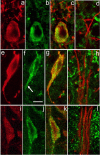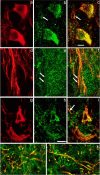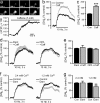Mobilization of calcium from intracellular stores facilitates somatodendritic dopamine release
- PMID: 19458227
- PMCID: PMC2892889
- DOI: 10.1523/JNEUROSCI.0181-09.2009
Mobilization of calcium from intracellular stores facilitates somatodendritic dopamine release
Abstract
Somatodendritic dopamine (DA) release in the substantia nigra pars compacta (SNc) shows a limited dependence on extracellular calcium concentration ([Ca(2+)](o)), suggesting the involvement of intracellular Ca(2+) stores. Here, using immunocytochemistry we demonstrate the presence of the sarcoplasmic/endoplasmic reticulum Ca(2+)-ATPase 2 (SERCA2) that sequesters cytosolic Ca(2+) into the endoplasmic reticulum (ER), as well as inositol 1,4,5-triphosphate receptors (IP(3)Rs) and ryanodine receptors (RyRs) in DAergic neurons. Notably, RyRs were clustered at the plasma membrane, poised for activation by Ca(2+) entry. Using fast-scan cyclic voltammetry to monitor evoked extracellular DA concentration ([DA](o)) in midbrain slices, we found that SERCA inhibition by cyclopiazonic acid (CPA) decreased evoked [DA](o) in the SNc, indicating a functional role for ER Ca(2+) stores in somatodendritic DA release. Implicating IP(3)R-dependent stores, an IP(3)R antagonist, 2-APB, also decreased evoked [DA](o). Moreover, DHPG, an agonist of group I metabotropic glutamate receptors (mGluR1s, which couple to IP(3) production), increased somatodendritic DA release, whereas CPCCOEt, an mGluR1 antagonist, suppressed it. Release suppression by mGluR1 blockade was prevented by 2-APB or CPA, indicating facilitation of DA release by endogenous glutamate acting via mGluR1s and IP(3)R-gated Ca(2+) stores. Similarly, activation of RyRs by caffeine increased [Ca(2+)](i) and elevated evoked [DA](o). The increase in DA release was prevented by a RyR blocker, dantrolene, and by CPA. Importantly, the efficacy of dantrolene was enhanced in low [Ca(2+)](o), suggesting a mechanism for maintenance of somatodendritic DA release with limited Ca(2+) entry. Thus, both mGluR1-linked IP(3)R- and RyR-dependent ER Ca(2+) stores facilitate somatodendritic DA release in the SNc.
Figures






Similar articles
-
Limited regulation of somatodendritic dopamine release by voltage-sensitive Ca channels contrasted with strong regulation of axonal dopamine release.J Neurochem. 2006 Feb;96(3):645-55. doi: 10.1111/j.1471-4159.2005.03519.x. Epub 2006 Jan 9. J Neurochem. 2006. PMID: 16405515
-
Novel Ca2+ dependence and time course of somatodendritic dopamine release: substantia nigra versus striatum.J Neurosci. 2001 Oct 1;21(19):7841-7. doi: 10.1523/JNEUROSCI.21-19-07841.2001. J Neurosci. 2001. PMID: 11567075 Free PMC article.
-
The contribution of intracellular calcium stores to mEPSCs recorded in layer II neurones of rat barrel cortex.J Physiol. 2002 Dec 1;545(2):521-35. doi: 10.1113/jphysiol.2002.022103. J Physiol. 2002. PMID: 12456831 Free PMC article.
-
Sarco-Endoplasmic Reticulum Calcium Release Model Based on Changes in the Luminal Calcium Content.Adv Exp Med Biol. 2020;1131:337-370. doi: 10.1007/978-3-030-12457-1_14. Adv Exp Med Biol. 2020. PMID: 31646517 Review.
-
Alterations of the Endoplasmic Reticulum (ER) Calcium Signaling Molecular Components in Alzheimer's Disease.Cells. 2020 Dec 1;9(12):2577. doi: 10.3390/cells9122577. Cells. 2020. PMID: 33271984 Free PMC article. Review.
Cited by
-
Immunocytochemical identification of proteins involved in dopamine release from the somatodendritic compartment of nigral dopaminergic neurons.Neuroscience. 2009 Dec 1;164(2):488-96. doi: 10.1016/j.neuroscience.2009.08.017. Epub 2009 Aug 12. Neuroscience. 2009. PMID: 19682556 Free PMC article.
-
Glutamatergic signaling by mesolimbic dopamine neurons in the nucleus accumbens.J Neurosci. 2010 May 19;30(20):7105-10. doi: 10.1523/JNEUROSCI.0265-10.2010. J Neurosci. 2010. PMID: 20484653 Free PMC article.
-
Dopamine release in the basal ganglia.Neuroscience. 2011 Dec 15;198:112-37. doi: 10.1016/j.neuroscience.2011.08.066. Epub 2011 Sep 14. Neuroscience. 2011. PMID: 21939738 Free PMC article. Review.
-
Spontaneous inhibitory synaptic currents mediated by a G protein-coupled receptor.Neuron. 2013 Jun 5;78(5):807-12. doi: 10.1016/j.neuron.2013.04.013. Neuron. 2013. PMID: 23764286 Free PMC article.
-
N-phenylpropyl-N'-substituted piperazines occupy sigma receptors and alter methamphetamine-induced hyperactivity in mice.Pharmacol Biochem Behav. 2016 Nov-Dec;150-151:198-206. doi: 10.1016/j.pbb.2016.11.003. Epub 2016 Nov 13. Pharmacol Biochem Behav. 2016. PMID: 27851908 Free PMC article.
References
-
- Avidor T, Clementi E, Schwartz L, Atlas D. Caffeine-induced transmitter release is mediated via ryanodine-sensitive channel. Neurosci Lett. 1994;165:133–136. - PubMed
-
- Baba-Aissa F, Raeymaekers L, Wuytack F, De Greef C, Missiaen L, Casteels R. Distribution of the organellar Ca2+ transport ATPase SERCA2 isoforms in the cat brain. Brain Res. 1996;743:141–153. - PubMed
-
- Beavo JA, Reifsnyder DH. Primary sequence of cyclic nucleotide phosphodiesterase isoenzymes and the design of selective inhibitors. Trends Pharmacol Sci. 1990;11:150–155. - PubMed
Publication types
MeSH terms
Substances
Grants and funding
LinkOut - more resources
Full Text Sources
Other Literature Sources
Miscellaneous
